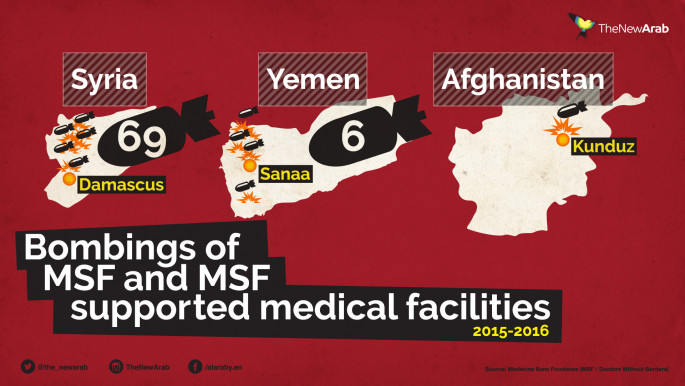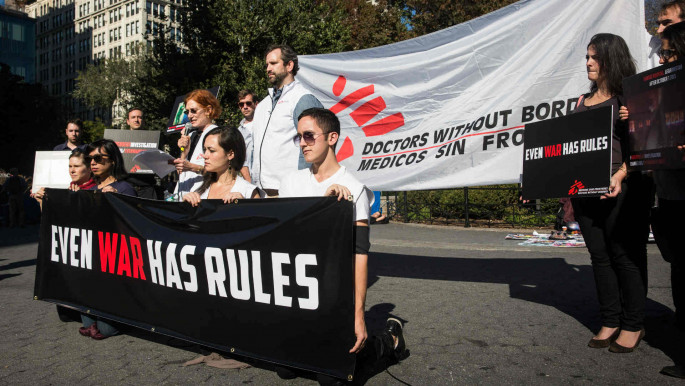A glimmer of hope in Afghanistan as MSF opens clinic two years after hospital bombing
Nearly two years after a series of US airstrikes destroyed their hospital in Kunduz, Medecins Sans Frontieres (MSF) has reopened a small clinic to treat minor trauma injuries and ailments.
While it comes as welcome news for Kunduz's overwhelmed medical authorities, it is nothing close to the capacity that MSF once offered in the region.
The US' self-investigation into the October 2015 bombing of MSF's Kunduz facility determined "human error" and communication failures were the reason for the attack.
Some 42 people were killed in the strikes, including 14 members of MSF's medical staff. Human rights groups at the time - including the United Nations human rights chief and MSF - called the bombing of the hospital a "war crime".
In the days following the attack, Christopher Stokes, MSF's general director, told the media that the statements coming from both Afghan and US authorities implied that "Afghan and US forces working together decided to raze to the ground a fully functioning hospital".
Silvia Dallatomasina, head of programmes for MSF in Afghanistan, told Reuters this week: "The opening of this clinic is the first step toward providing more medical assistance in Kunduz."
 |
In 2015, a US strike on an MSF operated hospital in Kunduz killed 42 civilians |  |
MSF had more than 100 meetings with US military and government officials, Dallatomasina said, and was in talks with all sides of the ongoing conflict in Afghanistan to reach assurances that another attack on their facility would not occur.
In a phone interview with their compound office in Kabul, MSF told The New Arab that the new clinic in Kunduz had far less capacity than its previous facility. It will not admit patients overnight, nor will staff there treat major injuries.
MSF was hopeful, however, about opening a new trauma centre in Kunduz as early as next year.
Although MSF has secured some assurances from the US military that their facilities will not be targeted in the future, this has not stopped the US military from either botching air raids or simply disregarding Afghan lives with reckless drone strikes - with two such incidents occuring in the past two weeks alone.
Helmand
On 21 July, US gunships mistakenly attacked Afghan security forces in Helmand in a "friendly fire" incident.
The air raid killed at least 16 Afghan police officers just 30 minutes after Afghan troops managed to recapture a key check point that had fallen to the Taliban the previous day.
Local officials in the Gereshk District of Helmand, where the botched air raid took place, say two others were also injured.
 |
The US dropped 1,634 bombs on Afghanistan in the first six months of 2017 - a 65 percent increase from the same time last year |  |
The "friendly fire" strike on Afghan police in Helmand comes as a heavy blow to Afghan security forces, who are hard pressed to make gains in a province which is predominantly controlled by the Taliban.
Helmand is alleged to be a major source of Taliban financing from opium cultivation and smuggling routes.
The US has accepted responsibility and announced an investigation into the deadly airstrike.
Nangarhar
On 23 July, just two days after the botched air raid in Helmand, the US military launched a drone strike on Haska Mena district in Nangarhar province. Here, reports of the strike made wildly different assertions.
Claims of the target ranged from a prayer ceremony, where only civilians were present, to statements coming from Attaullah Khogyani, the spokesman for Nangarhar's governor, who claimed that the strikes only killed members of IS-Khorasan, the Islamic State group's local franchise.
"Twenty-five [IS] affiliates, including three group leaders, were killed and 15 more wounded in air and ground operations in Haska Mena," he told Pajwok News.
It is believed that some fighting had taken place and that Khorasan fighters were present in the district - but not the neighbourhood through which the drone strike tore.
 |
|
Haska Mena residents told TOLO News that civilians were targeted during a prayer ceremony.
This version of the story is backed up by another account given to Pajwok News. One of the injured civilians from the drone strike, Chaman Gul, said that the bombing came as people were attending a prayer service for a deceased tribal elder, Haji Aman.
According to Afghan parliament member Asmatullah Shinwari, "eight people were killed including a woman and ten others were wounded".
"Such airstrikes should be stopped and the safety of civilians must be considered seriously," he added.
US Navy Captain Bill Salvin, a spokesman for US forces in Afghanistan, said in a statement that they were aware of reports regarding civilian casualties in Nangarhar, but said "we have no indications that civilians were in the area either before the strike or after the strike".
 |
We don't get straight answers from the Americans, a local Afghan official said. |  |
Despite the captain's comments, several mainstream media outlets in Afghanistan were reporting directly from hospitals in Jalalabad city, with pictures of and interviews with the injured.
A Nangarhar government official who spoke with The New Arab on condition of anonymity said that a delegation had been formed to investigate the claims of civilian casualties, but also said that in the past "we don't get straight answers from the Americans".
"When it comes to airstrikes, for instance in Khogyani, we aren't shown any proof of who the dead are to my knowledge, neither does any other official in the province," the official said.
According to the US Air Force's own figures, 1,634 bombs were dropped on Afghanistan in the first six months of 2017 - a marked increase of 65 percent from the same period last year.
The vast majority of these bombings go unreported in the media. Even when the bombings are reported, journalists are forced to depend on accounts coming from either the US military, the Afghan government or the Taliban - all of whom have clear and open patterns of either inflating numbers, minimising mistakes or just plain lying.
 |
|
| The bombing of the MSF hospital in Kunduz sparked protests around the world [Getty] |
'We don't know anything'
"With the pattern of US deception in Afghanistan, the US Air Force numbers need to be independently verified" says Emran Feroz, journalist and founder of the project Drone Memorial, a project set up to put names - as opposed to numbers - to those killed in US drone strikes.
"There is some amazing work being done by the London-based Bureau of Investigative Reporting, but they, like most of us, are heavily dependent on local reporting from remote areas which only cites government or US officials."
The issue of getting verified information from remote areas in Afghanistan does not just leave a lack of information, according to freelance journalist Ali Latifi. It has also left some of the most vulnerable countries abandoned.
"The biggest problem is that no one really follows up," Latifi told The New Arab.
"I've visited villages in Maidan Wardak and in Nangarhar where there have been drone strikes and whenever you ask the people there about what happens after a drone strike, they say no one from the government or the media or any NGO really comes and asks what happened."
 |
Boys as young as 12 who were anywhere in the vicinity of an airstrike would be considered 'militants' |  |
Feroz agrees with Latifi's assessment, but adds that drone strikes aren't just killing and injuring; they are also creating a mental health crisis.
"I was recently in Khost to follow up on reports of drone strikes and get the testimony of those affected for a book I'm writing on the perils of drone warfare," Feroz says.
"These people were completely abandoned."
He met one man who had lost all of his male relatives in a drone strike and was left to take care of dozens of women and children.
"He wasn't even present when the strike occurred, but was showing clear signs of emotional and mental crisis," Feroz said.
"There's an attack in a remote area practically every day and sometimes multiple times, in Afghanistan, and for the most part us journalists and even government officials - we don't know anything."
Denying access
The lack of access to remote areas and to the sites of airstrikes in Afghanistan is not simply a logistical problem or due to threats from various armed groups operating in the country, Latifi says.
The US is also doing its part in denying access to Afghan and international media.
The Obama administration, during its time in power, enacted a policy that could shield it from war crimes charges for miscalculated airstrikes.
Boys as young as 12 which were anywhere in the vicinity of an airstrike would be considered "militants".
Latifi says he has been in houses where members of the armed opposition are with their children, or the children of others.
"It's pretty clear how civilians can be killed in these sorts of attacks and passed off as 'militants' or 'terrorists' if no one goes or is allowed to go and ask any questions," he added, saying the US military had blocked him and other journalists directly from reporting.
"When we arrived in Achin, around noon the next day after the US dropped the MOAB, ANSF and local government officials hadn't even been to the site yet," he says.
"For a brief moment, all the world's attention was in one village in eastern Afghanistan, one of the most under-reported places on the planet, but no one could go inside to see what happened."
The US military decision not to allow local Afghan government officials into the area of Asad Khail in Achin district came as a slap in the face to many Afghans.
Mohammed Harun Arsalai is an independent journalist and political activist from the Bay Area of California, and co-founder of the independent media project, Documenting Afghanistan. Currently based in his native Afghanistan, Mohammed's recent work focuses on refugees, the War on Terror, and militant groups operating inside Afghanistan.
Follow him on Twitter: @ArsalaiH





 Follow the Middle East's top stories in English at The New Arab on Google News
Follow the Middle East's top stories in English at The New Arab on Google News


